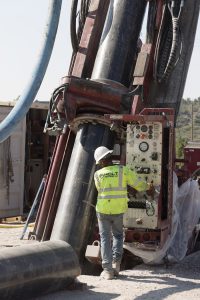
LOS ALAMOS, N.M. – EM crews have successfully completed a complex project that protects cultural and ecological resources throughout the Los Alamos National Laboratory (LANL) site while enabling more thorough monitoring and characterization of a contaminant plume in groundwater.
Crews with Newport News Nuclear BWXT-Los Alamos (N3B), the EM Los Alamos Field Office’s cleanup contractor, implemented angled drilling for a new monitoring well, a method that safeguards critical water resources and ensures preservation of pueblos’ nearby cultural sites.
The new well, named R-71, is located on the northwestern boundary of a hexavalent chromium plume in Mortandad Canyon.
Hexavalent chromium was flushed into Sandia Canyon between 1956 and 1972, when LANL personnel used the contaminant as a corrosion inhibitor in the cooling towers of its non-nuclear power plant. During that timeframe, chromium was used industry-wide for such purposes.
Angled drilling has proved effective for maintaining the integrity of a well’s proposed location without impacting the numerous cultural sites in Mortandad Canyon. N3B has completed four other angled wells around LANL.
“With angled drilling, tracking the trajectory of the borehole is crucial for determining the subsurface depths of geological formations and the water-producing zones we want to reach in relation to the hexavalent chromium plume,” said Tom Klepfer, drilling project manager with Tech2 Solutions, an N3B subcontractor. “We run several directional surveys during drilling to provide the precise data we need.”
To minimize potential disturbance when installing R-71, an existing well pad — the ground surface that crews level and fill with gravel to create a work area — was used to set up the drill rig and stage well construction materials.
Workers are nearly finished installing another groundwater monitoring well, known as R-72, located in the southwestern portion of the chromium plume. Vertical drilling methods were used for R-72, which will support additional plume characterization.
Installation of R-71 and R-72 will complete two fiscal year 2022 milestones under an agreement between DOE and the New Mexico Environment Department that guides the LANL legacy cleanup.
The cultural sites are non-renewable resources, according to Sean Dolan, N3B’s cultural resources specialist.
“This is our nation’s heritage, where people lived before European contact, and we can learn a lot from them, including how they farmed, their resilience in the face of a changing climate or how they migrated to survive,” Dolan said. “We understand and value the significance of these sites and always strive to protect them.”
Most cultural sites at LANL stem from ancient American Indian cultures, with the oldest dating back 7,000 years. Those sites include stone tools and pottery sherds, along with petroglyphs once used as a form of symbolic communication.
“By keeping these resources intact, we’re demonstrating our respect for the cultural traditions of the pueblos,” said Shawn Stone, N3B’s environmental programs and services director. “We’re also maintaining areas for visitation by tribal communities, which is crucial.”
-Contributor: Kate Keenan

